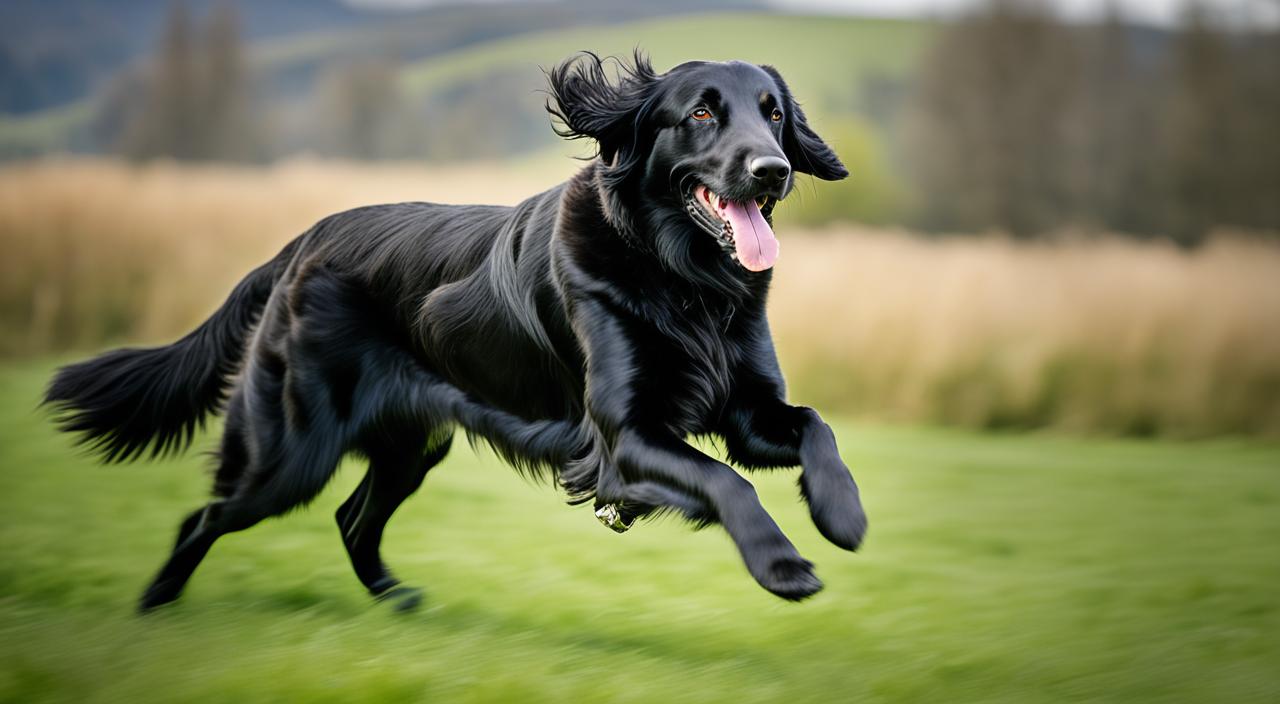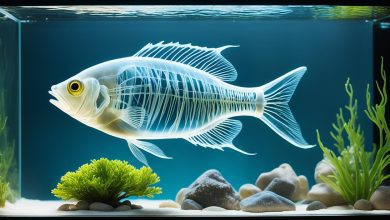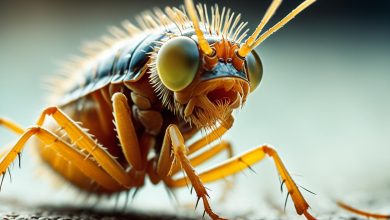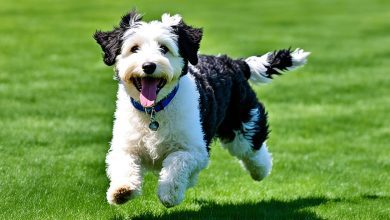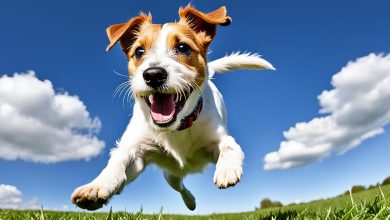My flat-coated retriever, Max, bounds across the park with pure joy. His silky black coat gleams in the sunlight. His enthusiasm for life is infectious, showing why these dogs make wonderful companions.
Flat-coated retrievers capture hearts with their cheerful nature and boundless energy. They excel at flushing and retrieving game, showcasing intelligence and athletic prowess. Their friendly demeanor and youthful spirit last into adulthood, making them ideal for outdoor adventures.
Originating from England, flat-coated retrievers have a unique long head and wide muzzle. Males typically weigh 60-70 pounds, while females range from 55-70 pounds. These active dogs need up to two hours of daily exercise.
They thrive on activities like running, swimming, and playing fetch. Flat-coated retrievers offer intelligence, trainability, and affection similar to Labradors and Golden Retrievers. Their high energy levels require ample space and committed owners.
Introduction to the Flat-Coated Retriever
Flat-Coated Retrievers are beloved members of the retriever family. They have a rich history in British sporting traditions. These dogs captivate enthusiasts with their graceful looks and versatile abilities.
Origins and Development
Flat-Coated Retrievers appeared in mid-19th century Britain. Skilled sportsmen and gamekeepers bred them to retrieve game birds. Their exact lineage is uncertain, but experts believe they came from various breeds.
These likely included Newfoundlands, spaniels, setters, and pointers. The goal was to create an excellent hunting companion.
Historical Significance in Hunting
From 1890 to World War I, Flat-Coated Retrievers were Britain’s top retriever breed. Their reliable nature and retrieving skills made them valuable hunting partners. Sewallis Evelyn Shirley helped stabilize the breed’s traits.
Modern-day Popularity
Flat-Coated Retrievers are gaining popularity again. In 2012, they ranked 92nd out of 177 breeds in AKC registrations. Though less common than other retrievers, their charm continues to win hearts.
| Year | AKC Registrations | Litters Registered | AKC Event Titles |
|---|---|---|---|
| 2012 | 552 | 96 | 1,116 |
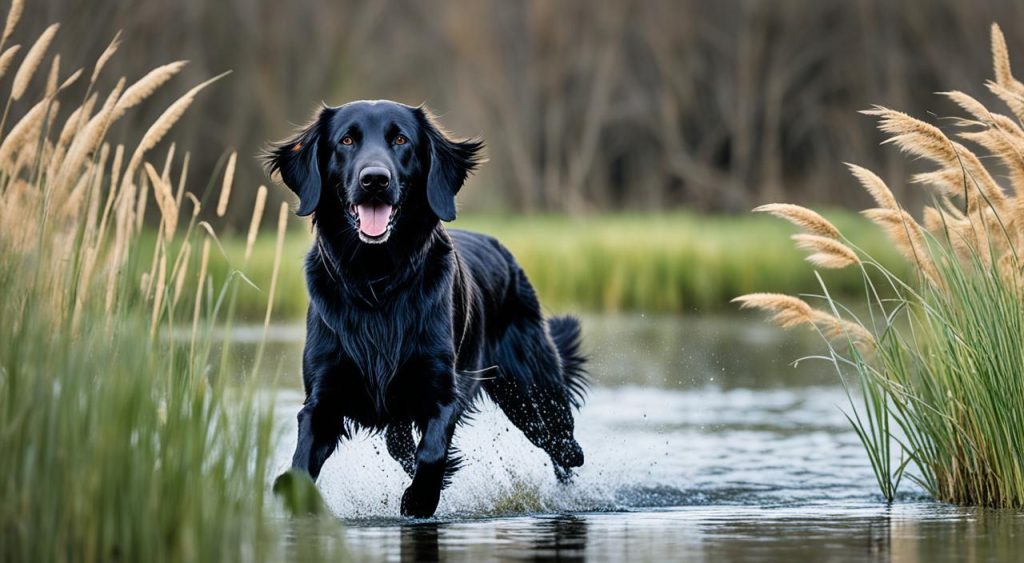
“The Flat-Coated Retriever is a biddable working companion, not segmented into performance versus show lines. Their reliable temperament makes them excellent companions for active families.”
Physical Characteristics of Flat-Coated Retrievers
Flat-Coated Retrievers are stunning black dogs that exemplify sporting breeds. Their unique appearance sets them apart from other retrievers. These athletic water dogs were originally bred as hunting companions.
Male Flat-Coats stand 23 to 24.5 inches tall. Females measure 22 to 23.5 inches. Both sexes typically weigh between 60 to 70 pounds.
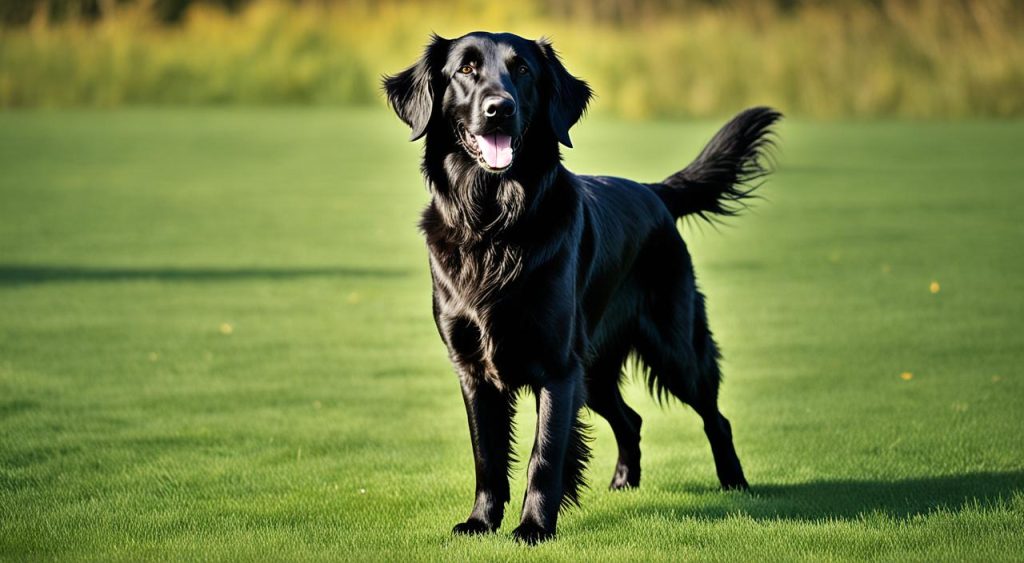
The breed’s most striking feature is its coat. It’s dense, lustrous, and lies flat against the body. This provides excellent protection from water and harsh weather.
Flat-Coats excel as water dogs. They can retrieve game from icy lakes or dense underbrush with ease.
| Feature | Description |
|---|---|
| Coat Color | Solid black or liver |
| Coat Texture | Dense, flat-lying, water-resistant |
| Head Shape | Skull and muzzle appear “cast in one piece” |
| Body Build | Strong, athletic, suited for retrieving |
The Flat-Coated Retriever’s head is another breed hallmark. Their skull and muzzle seem seamlessly connected, appearing “cast in one piece.” This feature adds to their unique charm.
Their intelligent expression enhances their appeal. Flat-Coats excel as both sporting dogs and family companions.
Temperament and Personality Traits
Flat-Coated Retrievers are friendly sporting dogs with cheerful demeanors. Their wagging tails and obedient nature make them delightful companions. These dogs keep a youthful spirit throughout life, earning the nickname “Peter Pan” of canines.
Cheerful and Outgoing Nature
Flat-Coated Retrievers greet everyone with enthusiasm. Their friendly nature extends to both humans and animals. This creates a harmonious household environment for social families.
Intelligence and Trainability
These dogs are smart and eager to please. They respond well to positive reinforcement techniques. Their quick learning ability suits them for various activities and sports.
Compatibility with Families and Children
Flat-Coated Retrievers are ideal family dogs. Their gentle disposition makes them excellent playmates for children. They form strong bonds with their human families and thrive on attention.
| Trait | Description |
|---|---|
| Temperament | Cheerful, outgoing, friendly |
| Intelligence | High, quick learners |
| Family Compatibility | Excellent, good with children |
| Exercise Needs | High, at least 60 minutes daily |
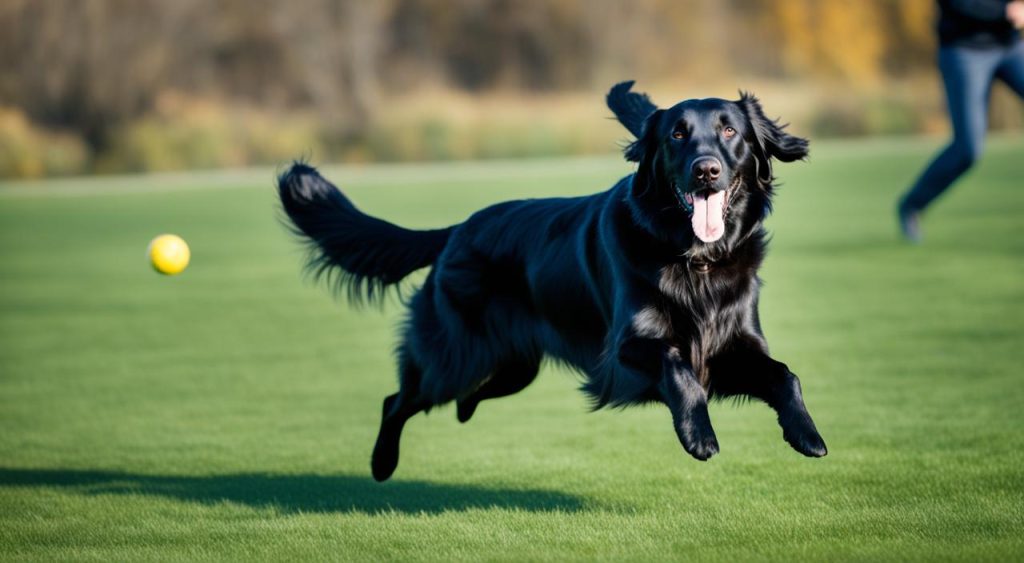
Flat-Coated Retrievers are perfect for active families seeking loyal, affectionate pets. Their intelligence, trainability, and friendly nature make them exceptional family dogs. These lovable companions adapt well to various family dynamics.
Flat-Coated Retriever as a Working Dog
Flat-Coated Retrievers excel as versatile working dogs, especially in hunting. These smart gun dogs are valuable companions for hunters and gamekeepers. They shine in various tasks, showcasing their adaptability and skills.
Flat-Coats are great at flushing birds like quail and pheasant. Their agility and keen nose make them perfect for upland shooting. They’re also skilled at retrieving game from land and water.
Flat-Coated Retrievers have a rich history as working dogs. The Kennel Club registered them among the first gundog breeds in 1873. They were the top retriever until the early 1900s.
“Sound, efficient movement is critical for a hunting retriever like the Flat-Coated Retriever.”
Some Flat-Coats are trained for service roles beyond hunting. Their smarts and trainability make them fit for various working dog positions. This shows their versatility in different fields.
| Trait | Description |
|---|---|
| Versatility | Excels in upland shooting and water retrieval |
| Historical Significance | One of the first registered gundog breeds (1873) |
| Working Roles | Hunting companion, service dog |
| Key Skills | Flushing birds, retrieving game, adaptability |
Exercise and Activity Requirements
Flat-Coated Retrievers are energetic sporting dogs that crave physical activity. These active pups need plenty of daily exercise to stay healthy and happy. Their hunting background fuels a strong drive for work and play.
Daily Exercise Needs
Flat-Coated Retrievers require at least 1-1.5 hours of vigorous activity each day. This high exercise need comes from their retriever heritage. A mix of walks, runs, and playtime keeps these dogs fit and content.
Without enough exercise, Flat-Coats might become restless or develop bad habits. Regular activity is key to their well-being.
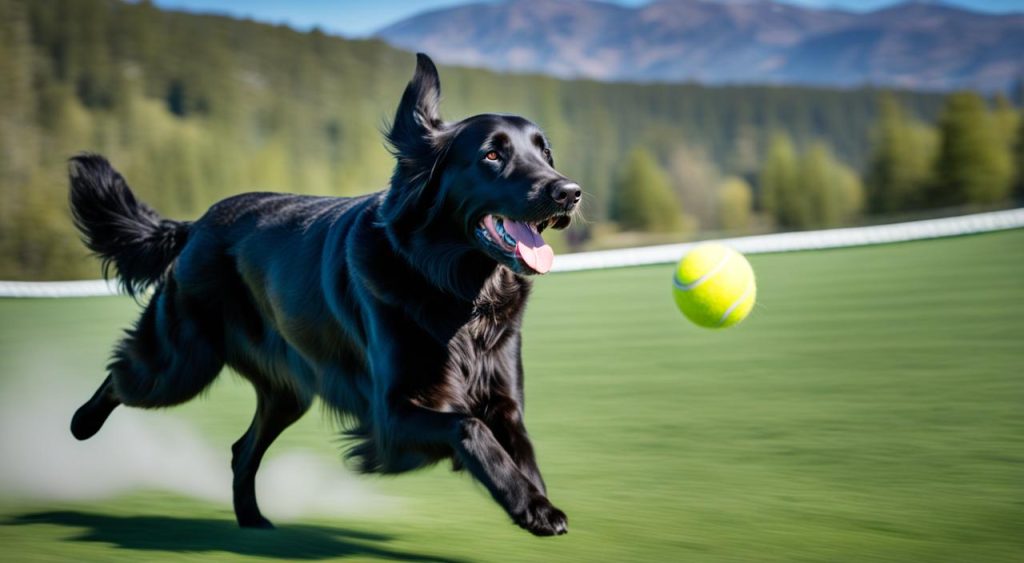
Suitable Activities and Sports
These versatile dogs excel in activities that tap into their retrieving instincts. Swimming, fetch games, and agility courses are great choices for Flat-Coated Retrievers. Canine sports like obedience trials or tracking events offer both physical and mental challenges.
Regular walks with off-leash time in safe areas let them explore and burn energy. These activities keep them happy and healthy.
Mental Stimulation Importance
Mental exercise is vital for Flat-Coated Retrievers. Puzzle toys, training sessions, and scent work games keep their minds sharp. Early socialization helps puppies become well-adjusted adults.
Consistent training, especially during adolescence, reinforces good behaviors. It also strengthens the bond between dog and owner.
| Exercise Type | Duration | Frequency |
|---|---|---|
| Vigorous Activity | 1-1.5 hours | Daily |
| Mental Stimulation | 15-30 minutes | 2-3 times daily |
| Off-leash Play | 30-45 minutes | 3-4 times weekly |
Grooming and Coat Maintenance
Flat-Coated Retrievers boast sleek black coats that need regular care. Weekly brushing prevents matting and removes loose hair. This grooming routine is vital for coat health and temperature control.
Focus on removing the undercoat during brushing sessions. Increase brushing frequency during shedding seasons. This helps manage excess fur effectively.
Bathe your Flat-Coated Retriever every three months or when necessary. Trim nails regularly and brush teeth daily. Professional grooming can help manage the undercoat of these retrievers.
| Grooming Task | Frequency |
|---|---|
| Brushing | Weekly (minimum) |
| Bathing | Every 3 months |
| Nail Trimming | Monthly |
| Teeth Brushing | Daily |
| Ear Cleaning | Monthly |
Good grooming keeps your Flat-Coated Retriever looking sharp and healthy. It also helps them resist water and regulate body temperature. This routine is essential for these active, water-loving dogs.
Health Considerations for Flat-Coated Retrievers
Flat-coated retrievers are beloved family dogs with a lifespan of 10 to 14 years. These energetic pups need special care to stay healthy. Regular attention helps maintain their vitality throughout their lives.
Common Health Issues
Flat-coated retrievers are generally healthy but face some breed-specific challenges. Cancer is a major concern, causing 69% of deaths in surveyed populations. They’re especially prone to histiocytic sarcoma.
Other health issues include hip and elbow dysplasia, eye problems, and bloat. Skin conditions and allergies can also affect these dogs.
Preventive Care
Regular vet check-ups are vital for these active dogs. Preventive measures include vaccinations against parvo, rabies, and distemper. Dental care helps prevent periodontal disease.
Weight management is crucial to avoid obesity-related issues. Parasite prevention for fleas, ticks, and heartworms is also important.
Aging Considerations
As flat-coated retrievers age, their care routine may need adjustments. Regular exercise remains important, but intensity should be reduced. Senior dogs may benefit from joint supplements and special diets.
These family dogs often keep their youthful spirit in their golden years. With proper care, flat-coated retrievers can be happy, healthy companions for a long time.
Training and Socialization Tips
Flat-Coated Retrievers are friendly and obedient companions. They’re smart and eager to please, making training easier. However, their lively nature may need extra attention during training sessions.
Early socialization is key for these dogs. It helps develop their natural friendliness. Consistent training from puppyhood prevents long-lasting puppy-like behaviors. Focus on basic commands like sit, stay, come, and fetch.
These dogs excel in many activities. They’re great at obedience, agility, flyball, and hunting trials. Regular exercise, including swimming, keeps them happy and healthy.
“Flat-Coated Retrievers thrive with engaging activities that challenge their intellect to keep their minds sharp.”
New owners might find a training guide book helpful. These books cover potty training, leash training, and socialization. They also offer advanced training tips for Flat-Coated Retrievers.
| Training Focus | Description |
|---|---|
| Basic Obedience | Sit, Drop, Come, Fetch, Stay, Wait |
| Behavioral Training | Stopping biting and chewing |
| Essential Skills | Potty training, Leash training, Socialization |
Flat-Coated Retrievers are sensitive dogs. Avoid harsh training methods. Use positive reinforcement to nurture their friendly nature. This approach creates a well-behaved, happy companion.
Flat-Coated Retriever vs. Other Retriever Breeds
Retriever breeds are famous for their hunting and sporting skills. The Flat-Coated Retriever has unique traits that set it apart. Let’s compare this breed to other popular retrievers.
Comparison with Labrador Retrievers
Flat-Coated and Labrador Retrievers share similarities as hunting dogs. Both are smart and eager to please. However, Flat-Coats are more energetic and mature slower.
They often keep puppy-like behavior into adulthood. This trait earned them the nickname “Peter Pan” of the dog world.
Differences from Golden Retrievers
Flat-Coated Retrievers differ from Golden Retrievers in several ways. They have a unique coat that lies flat against their body. Flat-Coats are more lively and need more exercise than Goldens.
| Characteristic | Flat-Coated Retriever | Golden Retriever |
|---|---|---|
| Weight | 55 – 80 lbs | 55 – 70 lbs |
| Height | 22″ – 25″ | 21″-24″ |
| Life Expectancy | 8 – 10 years | 8 – 12 years |
| Daily Exercise | 2 hours | 40 minutes to 1 hour |
| Daily Food Intake | 3 – 5 cups | 3 – 4 cups |
Unique Traits of Flat-Coated Retrievers
Flat-Coated Retrievers have distinct features that make them stand out. Their sleek coat and unique head shape are easy to spot. They excel in upland game and water retrieval.
These dogs have high energy levels and need constant engagement. Without proper exercise, they may develop behavioral issues.
All retriever breeds make great sporting dogs. However, Flat-Coated Retrievers offer a special mix of traits. Their energy, smarts, and looks make them ideal for active owners.
Adopting a Flat-Coated Retriever: What to Consider
Flat-coated retrievers are cheerful and active family dogs. They’re known for their friendly nature and energetic lifestyle. Before adopting, it’s important to understand their unique needs.
These pups need at least an hour of daily exercise. They love homes with plenty of space to run. Their friendly nature makes them great companions but not good guard dogs.
Weekly brushing keeps their sleek coat healthy. Regular vet visits are crucial for preventing hip dysplasia and eye problems.
| Characteristic | Rating (out of 5) |
|---|---|
| Energy Level | 3 |
| Exercise Requirements | 3 |
| Playfulness | 4 |
| Affection Level | 5 |
| Ease of Training | 5 |
Flat-coated retrievers typically live 10-12 years. They have a long puppyhood and stay playful for years. When adopting, choose trusted breeders or rescue groups.
Flat-Coated Retrievers in Competitive Sports and Shows
Flat-Coated Retrievers excel in competitive sports and shows. These obedient dogs shine in agility, obedience trials, and field tests. Their versatility as sporting dogs is truly impressive.
Sadie, a remarkable Flat-Coated Retriever, earned her second Master Agility Championship (MACH2) title. She competes twice monthly and trains almost daily. Her achievements showcase the breed’s intelligence and athletic ability.
Conformation shows evaluate the unique features of Flat-Coated Retrievers. Judges assess their distinctive head shape and coat quality. These events maintain breed standards and encourage responsible breeding practices.
The Flat-Coated Retriever Society of America honored Sadie’s accomplishments. In 2019, they inducted her into their Hall of Fame. This recognition highlights the breed’s potential in competitive sports.
Flat-Coated Retrievers face health challenges like hemangiosarcoma. Despite this, they continue to impress in competitions. Sadie’s MACH2 title after spleen removal shows the breed’s resilience.
Breed clubs actively work to conserve Flat-Coated Retrievers. They focus on improving health, increasing longevity, and preserving natural habitats. These efforts ensure the breed’s continued success in sports and shows.
FAQ
What is the origin of the Flat-Coated Retriever breed?
British sportsmen developed the Flat-Coated Retriever in the mid-19th century. They aimed to create a specialized hunting dog for retrieving game. The breed’s exact origins are uncertain, but likely involve crosses between Newfoundlands, spaniels, setters, and pointers.
What is the distinctive physical appearance of the Flat-Coated Retriever?
Flat-Coated Retrievers have a unique head shape, appearing “cast in one piece” in silhouette. Their dense, lustrous coat lies flat against the body. The breed standard allows for solid black or liver-colored coats.
What is the temperament and personality of the Flat-Coated Retriever like?
Flat-Coated Retrievers are known for their cheerful demeanor and constantly wagging tails. They maintain a youthful outlook well into old age. These dogs are intelligent, outgoing, and generally friendly towards strangers and other animals.
Are Flat-Coated Retrievers good working dogs?
Yes, Flat-Coated Retrievers excel in various hunting tasks. They’re skilled at flushing birds during upland shooting. These dogs are adept at retrieving game from both land and water.
What are the exercise and activity requirements for Flat-Coated Retrievers?
Flat-Coated Retrievers have high energy levels and need substantial daily exercise. They require both physical activity and mental stimulation. Suitable activities include long walks, runs, swimming, and retrieval games.
Agility, obedience, and tracking are also great options. Participation in retriever field trials can satisfy their natural instincts.
How should I groom and maintain the coat of a Flat-Coated Retriever?
Weekly brushing prevents matting and removes loose hair. Pay special attention to the undercoat during shedding seasons. Minimal trimming is necessary to preserve the coat’s insulating properties.
What are the common health concerns for Flat-Coated Retrievers?
Flat-Coated Retrievers may be prone to hip and elbow dysplasia, eye problems, and cancer. Regular vet check-ups are crucial for early detection and management of health issues.
How should I train and socialize a Flat-Coated Retriever?
Training Flat-Coated Retrievers requires patience and positive reinforcement methods. Early socialization is crucial to develop their natural friendliness. Consistent training from a young age is important, as they retain puppy-like behaviors for years.
How do Flat-Coated Retrievers compare to other retriever breeds?
Flat-Coated Retrievers are more energetic and slower to mature than Labrador Retrievers. They differ from Golden Retrievers in coat type and often in temperament. Flat-Coats are typically more exuberant and have unique traits like their distinctive head shape.
What should I consider before adopting a Flat-Coated Retriever?
Consider the Flat-Coated Retriever’s high energy levels and exercise needs. Their friendly nature makes them excellent family companions but poor guard dogs. Be prepared for their grooming requirements and potential health issues.
Do Flat-Coated Retrievers participate in competitive sports and shows?
Yes, Flat-Coated Retrievers excel in various competitive sports and shows. They stand out in agility, obedience, tracking, and retriever field trials. These dogs also participate in conformation shows, where judges evaluate their distinctive features.
